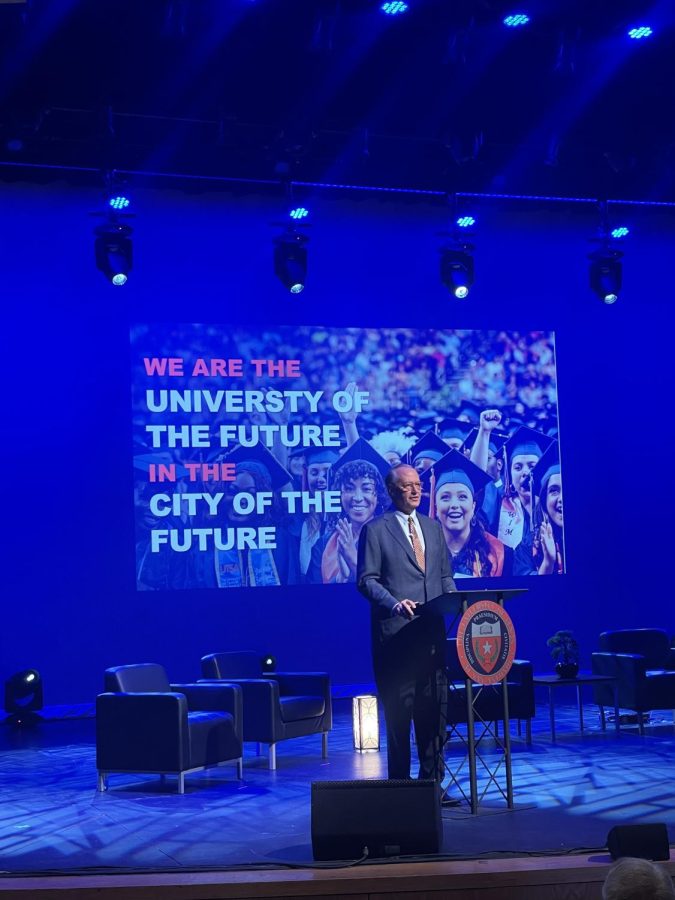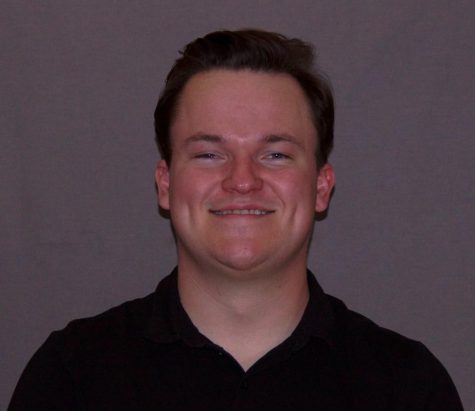UTSA hosts State of the University address
UTSA President Taylor Eighmy addressing the audience at his State of the University address.
February 7, 2023
As UTSA begins another academic year, President Taylor Eighmy hosted a State of the University address, followed by a panel discussion with faculty, staff and senior Public Health major Erica McFarland. On Monday, Jan. 30, Eighmy addressed an audience of leadership, faculty, students and staff in-person and online about the university’s trajectory.
Much of the address was centered around UTSA’s three strategic destinations. Eighmy took time at the beginning of the conversation to recognize where the university is today while looking toward the future, returning to the belief that “great cities need great universities.”
“The concept of our great city of San Antonio needing us to be a great university is a powerful driver for where we have been going, where we are today and where we will go,” Eighmy said.
At the beginning of the Fall 2022 semester, UTSA launched its Bold Scholar Program, bringing in about 220 first-year students to live on campus for their first year of college.
Eighmy acknowledged the changing landscape of higher education and UTSA’s place within that.
“One big feature … especially for public higher education is that we will be measured now not by the exclusiveness of our admissions policies, but by our inclusiveness; about who we let in and who we advance,” Eighmy said.
In speaking about this, there was a graphic displaying some of UTSA’s rankings around economic & social mobility. For example, the graphic included data from Georgetown University’s Center on Education and the Workforce, which lists UTSA in the top 18% of the nation for long-term return on investment.
“We’re crushing it in how well we do around advancing economic mobility,” Eighmy said.
Eighmy took time to recognize the partnership with UT Health San Antonio.
“We’re grateful for that,” Eighmy said. “The fact that we could work to bring forward a joint school of public health for San Antonio is immensely powerful.”
In moving to the discussion around the second strategic destination, Eighmy expressed his gratitude for UTSA’s R1 classification.
“You know how much I care about the Carnegie Foundation, and the fact that we were confirmed as an R1 institution was a profound step forward for us,” Eighmy said. “This effort didn’t happen just five [to] six years ago when I arrived, there was a foundation built here to move our institution in that direction, and we just amplified it. It’s an important waypoint for us.”
Texas now has 11 universities with the R1 classification recognizing excellence in research.
With its R1 classification, UTSA is also a founding member of the Alliance of Hispanic-Serving Institutions. Eighmy declared the recognition as one of utmost value.
“This group … is predictive of what public higher education in the United States will be,” Eighmy said. “We are the future, and the alliance is very representative of that.”
As San Antonio’s population inevitably grows, so does UTSA’s infrastructure and resources. On Jan. 9, UTSA celebrated the grand opening of San Pedro I, the home to UTSA’s School of Data Science, and the start of the vision for Downtown.
With the changing landscape around classroom modalities and hybrid learning, the university has begun to renovate existing classrooms to match that change. According to Eighmy, 40% of core classrooms have been renovated.
Another point of interest for UTSA was acquiring the Southwest School of Art.
“Our acquisition of their assets, their campus, is going to prove to be profoundly impactful for us as we think about the future of arts in San Antonio,” Eighmy said. “We think about our presence downtown in a community that desperately needs a downtown university presence.”
Eighmy praised this as a chance for UTSA to strengthen its presence in the city further. He recognized that UTSA is emulating Arizona State’s model for a downtown university presence.
“Most presidents are very jealous of the fact that we have real estate and we have campuses like we do,” Eighmy said. “They’re all very aware that we’re emulating, a little bit, Arizona State’s creation of a whole, ‘new university,’ essentially in downtown Phoenix … that we’re modeling that sort of thing here. Everybody is very aware of that; it’s very profound.”
Eighmy expressed enthusiasm about the soon-to-open Park West Fieldhouse. He recognized the effort as a “wonderful partnership with the city and county.”
Looking to the rest of 2023, Eighmy again noted the future of higher education and the many questions that come with that change. Furthermore, he focused on the concept of return on investment around experiential learning opportunities and “preparing career-ready Roadrunners.”
Later this year, UTSA will break ground on San Pedro II. The complex will strive to highlight a multidisciplinary approach to business, engineering and sciences. Eighmy noted that capital projects like this come from many places.
“A lot of our capital projects come from dollars that are provided by UT System, the legislature or donors that are intended to be used for capital projects,” Eighmy said. “We’re going to continue to grow our capital infrastructure as we grow our enrollment; we need both. [And] we’ll be wise stewards of our investment strategies.”
Eighmy also plans for a follow-up to the Campus Climate Survey while recognizing future progress to be made on institution-wide issues.
UTSA will soon be a part of the American Athletic Conference (AAC). Eighmy recognized the support that would come from “operating at a conference level that is higher than Conference-USA.”
Eigmy then noted the construction that will soon occur on a training facility for UTSA’s basketball and volleyball teams.
In his closing remarks, Eighmy noted the work happening in Texas’ 88th Legislative Session.
“Even though we have a very positive focus, and we have a system in place to be deeply engaged in Austin … we have this very challenging and concerning component of the session that we’re gonna have to work hard on,” Eighmy said.
Eighmy looked at his history before arriving at UTSA and how those different sessions were similar.
“When I was at Tennessee, the issues that came out of the Legislature there were identical to the ones that you’re seeing in Florida now; we were able to navigate those things,” Eighmy said. “I feel optimistic.”
Eighmy reiterated his belief in UTSA as essential to Texas’ higher education landscape.
“We are part of the solution for Texas remaining this knowledge enterprise for the nation,” Eighmy said. “We are part of the solution. So we are going to advocate that way as we go through the session.”
Three questions were addressed at the end of the panel discussion before time ran out. Eighmy clarified that the questions that needed to be addressed would be compiled and answered by university leadership to the best of their ability. When submitting questions, attendees had to provide their email, so it is assumed the answers will be sent to attendees. To watch the entire 2023 State of the University, click here.












